Yaochen Zhu
Learning from Diverse Reasoning Paths with Routing and Collaboration
Aug 23, 2025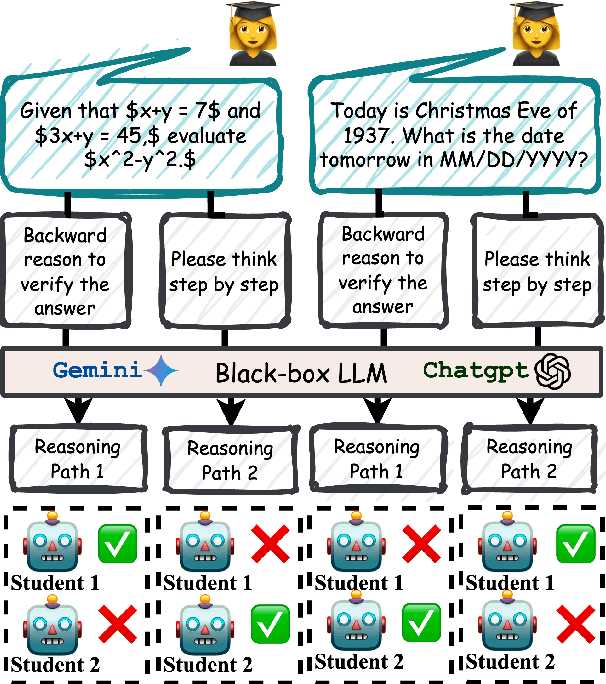
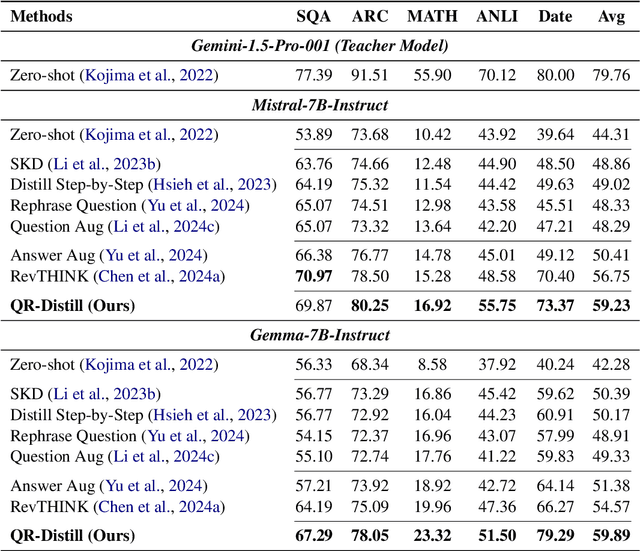
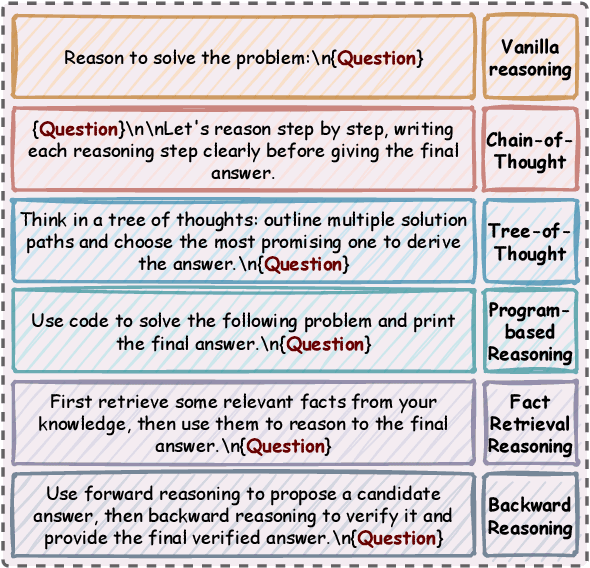
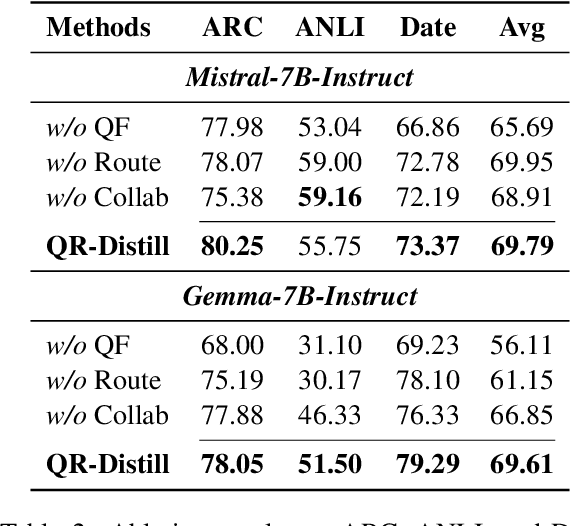
Abstract:Advances in large language models (LLMs) significantly enhance reasoning capabilities but their deployment is restricted in resource-constrained scenarios. Knowledge distillation addresses this by transferring knowledge from powerful teacher models to compact and transparent students. However, effectively capturing the teacher's comprehensive reasoning is challenging due to conventional token-level supervision's limited scope. Using multiple reasoning paths per query alleviates this problem, but treating each path identically is suboptimal as paths vary widely in quality and suitability across tasks and models. We propose Quality-filtered Routing with Cooperative Distillation (QR-Distill), combining path quality filtering, conditional routing, and cooperative peer teaching. First, quality filtering retains only correct reasoning paths scored by an LLM-based evaluation. Second, conditional routing dynamically assigns paths tailored to each student's current learning state. Finally, cooperative peer teaching enables students to mutually distill diverse insights, addressing knowledge gaps and biases toward specific reasoning styles. Experiments demonstrate QR-Distill's superiority over traditional single- and multi-path distillation methods. Ablation studies further highlight the importance of each component including quality filtering, conditional routing, and peer teaching in effective knowledge transfer. Our code is available at https://github.com/LzyFischer/Distill.
Graph Prompting for Graph Learning Models: Recent Advances and Future Directions
Jun 10, 2025Abstract:Graph learning models have demonstrated great prowess in learning expressive representations from large-scale graph data in a wide variety of real-world scenarios. As a prevalent strategy for training powerful graph learning models, the "pre-training, adaptation" scheme first pre-trains graph learning models on unlabeled graph data in a self-supervised manner and then adapts them to specific downstream tasks. During the adaptation phase, graph prompting emerges as a promising approach that learns trainable prompts while keeping the pre-trained graph learning models unchanged. In this paper, we present a systematic review of recent advancements in graph prompting. First, we introduce representative graph pre-training methods that serve as the foundation step of graph prompting. Next, we review mainstream techniques in graph prompting and elaborate on how they design learnable prompts for graph prompting. Furthermore, we summarize the real-world applications of graph prompting from different domains. Finally, we discuss several open challenges in existing studies with promising future directions in this field.
Collaborative Retrieval for Large Language Model-based Conversational Recommender Systems
Feb 19, 2025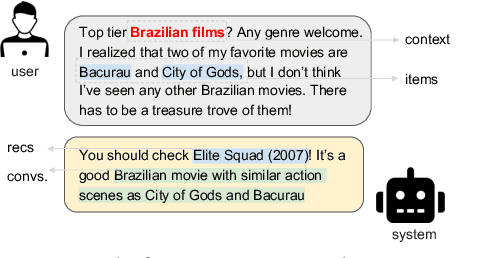

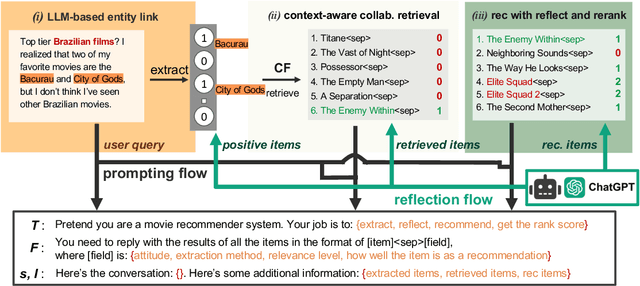
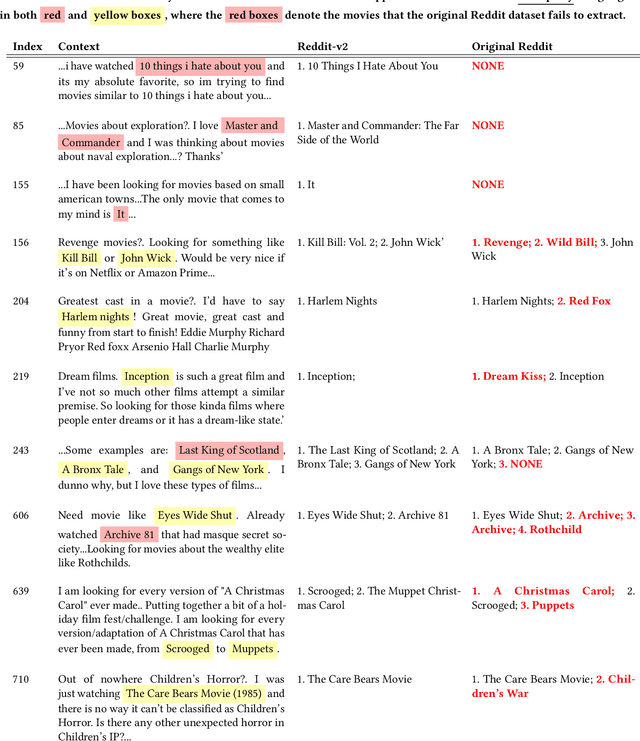
Abstract:Conversational recommender systems (CRS) aim to provide personalized recommendations via interactive dialogues with users. While large language models (LLMs) enhance CRS with their superior understanding of context-aware user preferences, they typically struggle to leverage behavioral data, which have proven to be important for classical collaborative filtering (CF)-based approaches. For this reason, we propose CRAG, Collaborative Retrieval Augmented Generation for LLM-based CRS. To the best of our knowledge, CRAG is the first approach that combines state-of-the-art LLMs with CF for conversational recommendations. Our experiments on two publicly available movie conversational recommendation datasets, i.e., a refined Reddit dataset (which we name Reddit-v2) as well as the Redial dataset, demonstrate the superior item coverage and recommendation performance of CRAG, compared to several CRS baselines. Moreover, we observe that the improvements are mainly due to better recommendation accuracy on recently released movies. The code and data are available at https://github.com/yaochenzhu/CRAG.
Generative Risk Minimization for Out-of-Distribution Generalization on Graphs
Feb 11, 2025Abstract:Out-of-distribution (OOD) generalization on graphs aims at dealing with scenarios where the test graph distribution differs from the training graph distributions. Compared to i.i.d. data like images, the OOD generalization problem on graph-structured data remains challenging due to the non-i.i.d. property and complex structural information on graphs. Recently, several works on graph OOD generalization have explored extracting invariant subgraphs that share crucial classification information across different distributions. Nevertheless, such a strategy could be suboptimal for entirely capturing the invariant information, as the extraction of discrete structures could potentially lead to the loss of invariant information or the involvement of spurious information. In this paper, we propose an innovative framework, named Generative Risk Minimization (GRM), designed to generate an invariant subgraph for each input graph to be classified, instead of extraction. To address the challenge of optimization in the absence of optimal invariant subgraphs (i.e., ground truths), we derive a tractable form of the proposed GRM objective by introducing a latent causal variable, and its effectiveness is validated by our theoretical analysis. We further conduct extensive experiments across a variety of real-world graph datasets for both node-level and graph-level OOD generalization, and the results demonstrate the superiority of our framework GRM.
Collaborative Diffusion Model for Recommender System
Jan 31, 2025



Abstract:Diffusion-based recommender systems (DR) have gained increasing attention for their advanced generative and denoising capabilities. However, existing DR face two central limitations: (i) a trade-off between enhancing generative capacity via noise injection and retaining the loss of personalized information. (ii) the underutilization of rich item-side information. To address these challenges, we present a Collaborative Diffusion model for Recommender System (CDiff4Rec). Specifically, CDiff4Rec generates pseudo-users from item features and leverages collaborative signals from both real and pseudo personalized neighbors identified through behavioral similarity, thereby effectively reconstructing nuanced user preferences. Experimental results on three public datasets show that CDiff4Rec outperforms competitors by effectively mitigating the loss of personalized information through the integration of item content and collaborative signals.
Global Graph Counterfactual Explanation: A Subgraph Mapping Approach
Oct 25, 2024



Abstract:Graph Neural Networks (GNNs) have been widely deployed in various real-world applications. However, most GNNs are black-box models that lack explanations. One strategy to explain GNNs is through counterfactual explanation, which aims to find minimum perturbations on input graphs that change the GNN predictions. Existing works on GNN counterfactual explanations primarily concentrate on the local-level perspective (i.e., generating counterfactuals for each individual graph), which suffers from information overload and lacks insights into the broader cross-graph relationships. To address such issues, we propose GlobalGCE, a novel global-level graph counterfactual explanation method. GlobalGCE aims to identify a collection of subgraph mapping rules as counterfactual explanations for the target GNN. According to these rules, substituting certain significant subgraphs with their counterfactual subgraphs will change the GNN prediction to the desired class for most graphs (i.e., maximum coverage). Methodologically, we design a significant subgraph generator and a counterfactual subgraph autoencoder in our GlobalGCE, where the subgraphs and the rules can be effectively generated. Extensive experiments demonstrate the superiority of our GlobalGCE compared to existing baselines. Our code can be found at https://anonymous.4open.science/r/GlobalGCE-92E8.
Understanding and Modeling Job Marketplace with Pretrained Language Models
Aug 08, 2024Abstract:Job marketplace is a heterogeneous graph composed of interactions among members (job-seekers), companies, and jobs. Understanding and modeling job marketplace can benefit both job seekers and employers, ultimately contributing to the greater good of the society. However, existing graph neural network (GNN)-based methods have shallow understandings of the associated textual features and heterogeneous relations. To address the above challenges, we propose PLM4Job, a job marketplace foundation model that tightly couples pretrained language models (PLM) with job market graph, aiming to fully utilize the pretrained knowledge and reasoning ability to model member/job textual features as well as various member-job relations simultaneously. In the pretraining phase, we propose a heterogeneous ego-graph-based prompting strategy to model and aggregate member/job textual features based on the topological structure around the target member/job node, where entity type embeddings and graph positional embeddings are introduced accordingly to model different entities and their heterogeneous relations. Meanwhile, a proximity-aware attention alignment strategy is designed to dynamically adjust the attention of the PLM on ego-graph node tokens in the prompt, such that the attention can be better aligned with job marketplace semantics. Extensive experiments at LinkedIn demonstrate the effectiveness of PLM4Job.
Merge, Ensemble, and Cooperate! A Survey on Collaborative Strategies in the Era of Large Language Models
Jul 08, 2024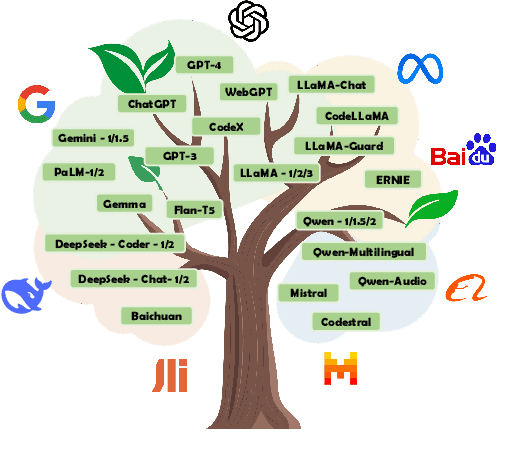


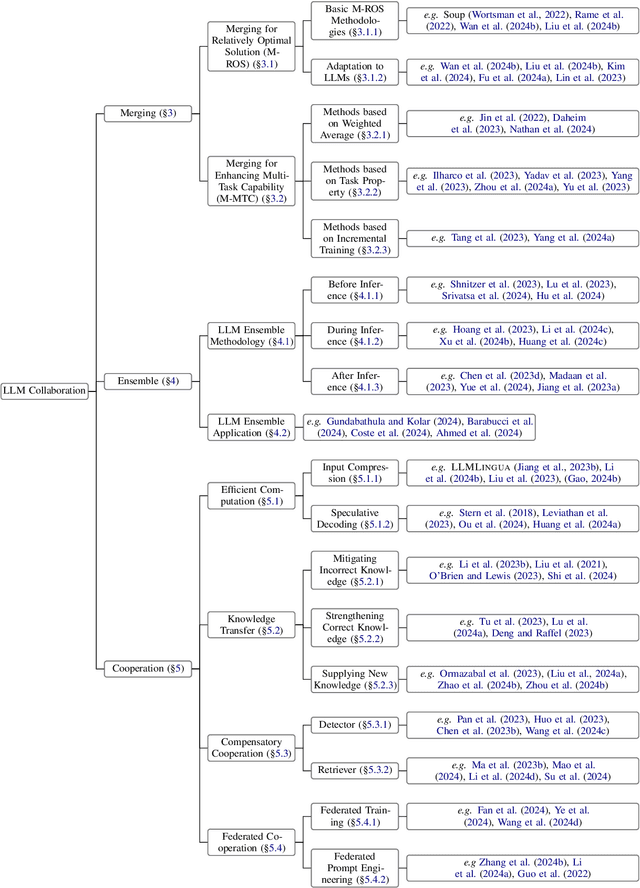
Abstract:The remarkable success of Large Language Models (LLMs) has ushered natural language processing (NLP) research into a new era. Despite their diverse capabilities, LLMs trained on different corpora exhibit varying strengths and weaknesses, leading to challenges in maximizing their overall efficiency and versatility. To address these challenges, recent studies have explored collaborative strategies for LLMs. This paper provides a comprehensive overview of this emerging research area, highlighting the motivation behind such collaborations. Specifically, we categorize collaborative strategies into three primary approaches: Merging, Ensemble, and Cooperation. Merging involves integrating multiple LLMs in the parameter space. Ensemble combines the outputs of various LLMs. Cooperation} leverages different LLMs to allow full play to their diverse capabilities for specific tasks. We provide in-depth introductions to these methods from different perspectives and discuss their potential applications. Additionally, we outline future research directions, hoping this work will catalyze further studies on LLM collaborations and paving the way for advanced NLP applications.
Consistency and Discrepancy-Based Contrastive Tripartite Graph Learning for Recommendations
Jul 06, 2024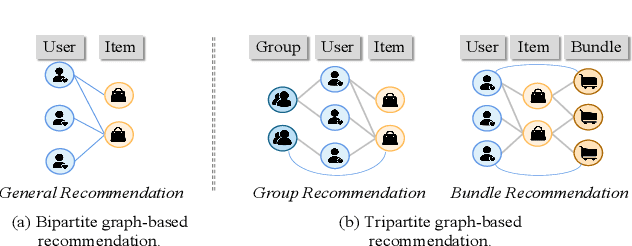
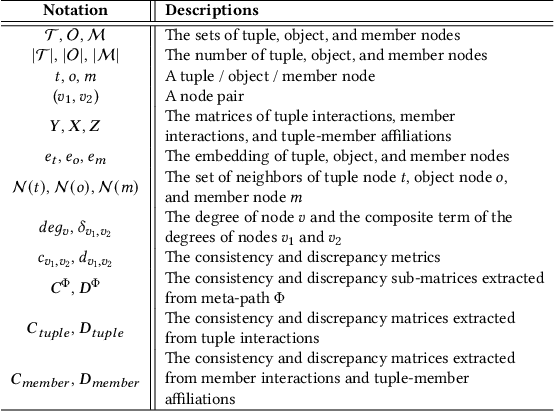
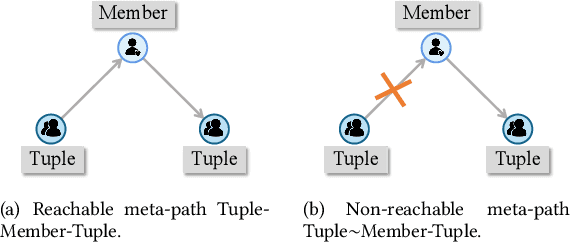

Abstract:Tripartite graph-based recommender systems markedly diverge from traditional models by recommending unique combinations such as user groups and item bundles. Despite their effectiveness, these systems exacerbate the longstanding cold-start problem in traditional recommender systems, because any number of user groups or item bundles can be formed among users or items. To address this issue, we introduce a Consistency and Discrepancy-based graph contrastive learning method for tripartite graph-based Recommendation. This approach leverages two novel meta-path-based metrics consistency and discrepancy to capture nuanced, implicit associations between the recommended objects and the recommendees. These metrics, indicative of high-order similarities, can be efficiently calculated with infinite graph convolutional networks layers under a multi-objective optimization framework, using the limit theory of GCN.
Causal Inference with Latent Variables: Recent Advances and Future Prospectives
Jun 20, 2024Abstract:Causality lays the foundation for the trajectory of our world. Causal inference (CI), which aims to infer intrinsic causal relations among variables of interest, has emerged as a crucial research topic. Nevertheless, the lack of observation of important variables (e.g., confounders, mediators, exogenous variables, etc.) severely compromises the reliability of CI methods. The issue may arise from the inherent difficulty in measuring the variables. Additionally, in observational studies where variables are passively recorded, certain covariates might be inadvertently omitted by the experimenter. Depending on the type of unobserved variables and the specific CI task, various consequences can be incurred if these latent variables are carelessly handled, such as biased estimation of causal effects, incomplete understanding of causal mechanisms, lack of individual-level causal consideration, etc. In this survey, we provide a comprehensive review of recent developments in CI with latent variables. We start by discussing traditional CI techniques when variables of interest are assumed to be fully observed. Afterward, under the taxonomy of circumvention and inference-based methods, we provide an in-depth discussion of various CI strategies to handle latent variables, covering the tasks of causal effect estimation, mediation analysis, counterfactual reasoning, and causal discovery. Furthermore, we generalize the discussion to graph data where interference among units may exist. Finally, we offer fresh aspects for further advancement of CI with latent variables, especially new opportunities in the era of large language models (LLMs).
 Add to Chrome
Add to Chrome Add to Firefox
Add to Firefox Add to Edge
Add to Edge